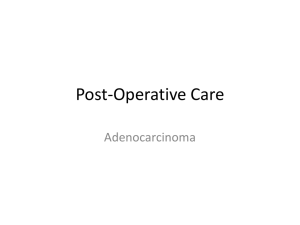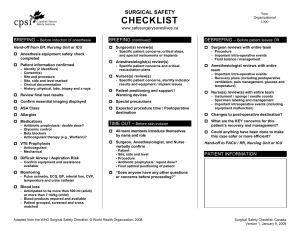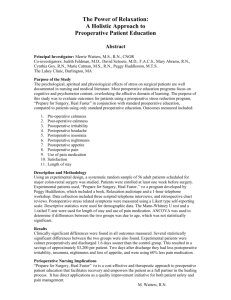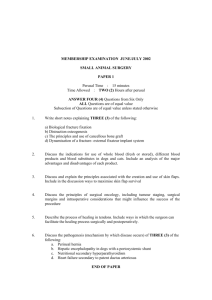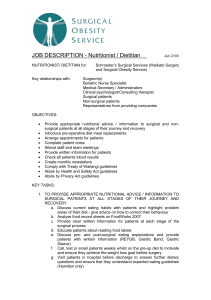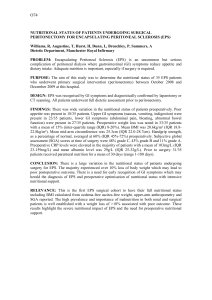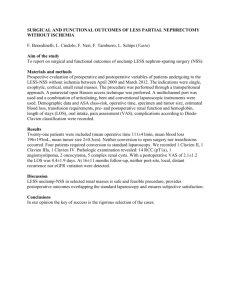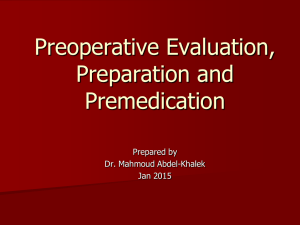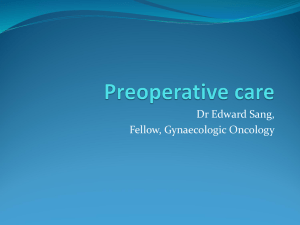Perioperative Care
advertisement
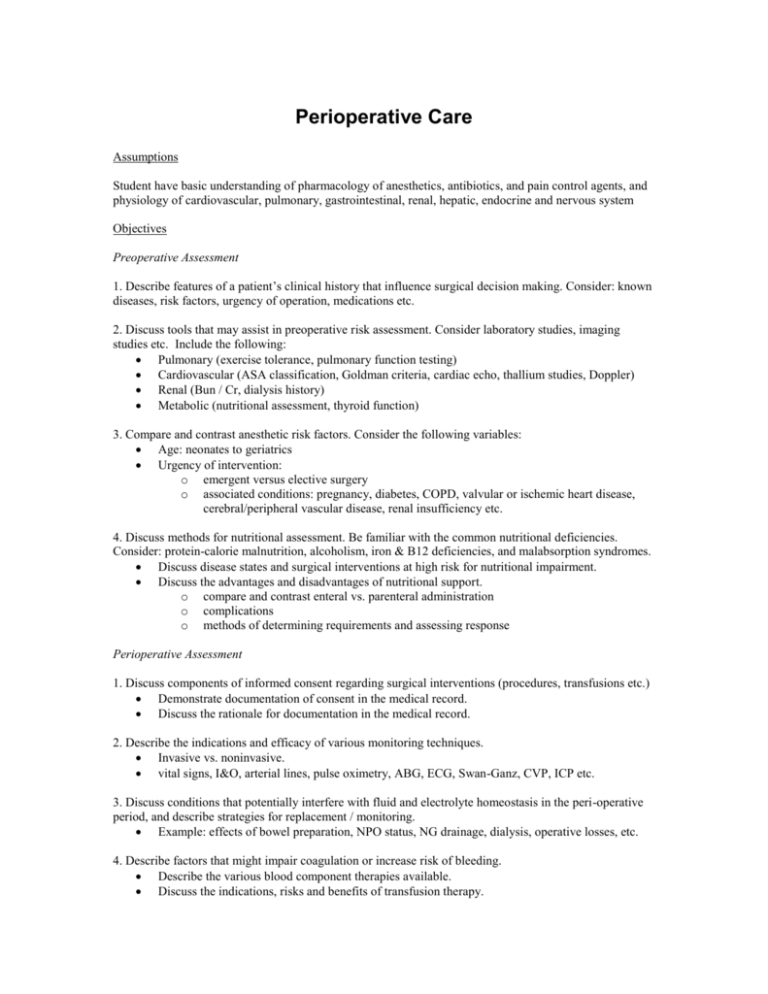
Perioperative Care Assumptions Student have basic understanding of pharmacology of anesthetics, antibiotics, and pain control agents, and physiology of cardiovascular, pulmonary, gastrointestinal, renal, hepatic, endocrine and nervous system Objectives Preoperative Assessment 1. Describe features of a patient’s clinical history that influence surgical decision making. Consider: known diseases, risk factors, urgency of operation, medications etc. 2. Discuss tools that may assist in preoperative risk assessment. Consider laboratory studies, imaging studies etc. Include the following: Pulmonary (exercise tolerance, pulmonary function testing) Cardiovascular (ASA classification, Goldman criteria, cardiac echo, thallium studies, Doppler) Renal (Bun / Cr, dialysis history) Metabolic (nutritional assessment, thyroid function) 3. Compare and contrast anesthetic risk factors. Consider the following variables: Age: neonates to geriatrics Urgency of intervention: o emergent versus elective surgery o associated conditions: pregnancy, diabetes, COPD, valvular or ischemic heart disease, cerebral/peripheral vascular disease, renal insufficiency etc. 4. Discuss methods for nutritional assessment. Be familiar with the common nutritional deficiencies. Consider: protein-calorie malnutrition, alcoholism, iron & B12 deficiencies, and malabsorption syndromes. Discuss disease states and surgical interventions at high risk for nutritional impairment. Discuss the advantages and disadvantages of nutritional support. o compare and contrast enteral vs. parenteral administration o complications o methods of determining requirements and assessing response Perioperative Assessment 1. Discuss components of informed consent regarding surgical interventions (procedures, transfusions etc.) Demonstrate documentation of consent in the medical record. Discuss the rationale for documentation in the medical record. 2. Describe the indications and efficacy of various monitoring techniques. Invasive vs. noninvasive. vital signs, I&O, arterial lines, pulse oximetry, ABG, ECG, Swan-Ganz, CVP, ICP etc. 3. Discuss conditions that potentially interfere with fluid and electrolyte homeostasis in the peri-operative period, and describe strategies for replacement / monitoring. Example: effects of bowel preparation, NPO status, NG drainage, dialysis, operative losses, etc. 4. Describe factors that might impair coagulation or increase risk of bleeding. Describe the various blood component therapies available. Discuss the indications, risks and benefits of transfusion therapy. Consider: packed cells vs. whole blood , FFP, platelets, cryoprecipitate, albumin. Discuss alternatives to allogeneic blood transfusion and their appropriate use. Include: autologous donation, hemodilution, iron / erythropoetin therapy, and modification of transfusion trigger. 5. Discuss risk factors for alcohol withdrawal syndromes. Consider prevention strategies. Postoperative Assessment 1. List conditions necessary for discharge of a patient to home or to the floor following an anesthetic. 2. Understand the pharmacological action, benefits, risks, and side effects of various pain control agents. parenteral vs. enteral agents, role of epidural and nerve blocks 3. Describe the expected outcomes of uncomplicated surgical procedures. Consider: Time to recovery, order of recovery of digestive function (stomach, small bowel, colon) etc. Characteristics of a healing surgical wound. Impact of various incisions on recovery. Functional abilities and disabilities acutely and chronically. Nutritional and fluid needs and options for replacement. Potential complications and prevention strategies. Patient support systems and options for post-hospital care. 4. Describe criteria for admission of a patient to an ICU or special care unit following surgery. Compare and contrast post-operative courses of patients undergoing Whipple procedure, CABG, trauma surgery with craniotomy, laparotomy and orthopedic repairs. List criteria for weaning a patient from the ventilator post-operatively. Problems 1. A 65-year-old man is undergoing a left total knee replacement. He has a history of adult onset diabetes, a previous myocardial infarction and smokes 1 pack of cigarettes daily. What type of preoperative assessment is indicated? What postoperative problems must you anticipate? What postoperative orders would you write? 2. A 24-year-old male with chronic renal failure undergoes placement of a prosthetic dialysis shunt in his right arm. Blood loss is 50 cc. His hemoglobin values are 7.0 gm/dl pre-op and 5.8 gm/dl post-op. When should he be dialyzed perioperatively? Why? Is a blood transfusion indicated? Discuss pros and cons, and alternatives. 3. A 7-week-old admitted for vomiting and dehydration will require surgery for pyloric stenosis. What issues must be addressed preoperatively? What concerns are there for infants undergoing anesthesia that differ from adults? Compose postoperative orders. Prevention 1. Describe what is meant by the term prophylaxis and discuss its rationale in preventing infectious and pulmonary complications. 2. Discuss alternatives, including their appropriate uses and risks, for prophylaxis of DVT and PE. 3. Discuss the indications for antibiotic prophylaxis; include commonly utilized agents, timing and duration of prophylaxis. Consider alternatives in patients with known drug allergies. 4. Discuss the rationale for bowel preps in patient undergoing various abdominal surgeries. 5. Describe modifications in diet, chronic medications, behavior (smoking, alcohol) that might be indicated in patients undergoing major surgery.

